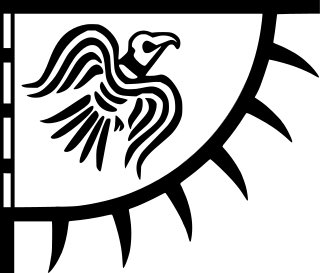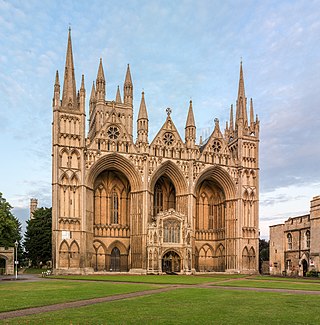Related Research Articles

The Kingdom of the West Saxons, also known as the Kingdom of Wessex, was an Anglo-Saxon kingdom in the south of Great Britain, from around 519 until England was unified in 927.
Godwin of Wessex was an English nobleman who became one of the most powerful earls in England under the Danish king Cnut the Great and his successors. Cnut made Godwin the first Earl of Wessex. Godwin was the father of King Harold II and of Edith of Wessex, who in 1045 married King Edward the Confessor.

Edward the Confessor was an Anglo-Saxon English king and saint. Usually considered the last king of the House of Wessex, he ruled from 1042 until his death in 1066.

Harold I, also known as Harold Harefoot, was regent of England from 1035 to 1037 and King of the English from 1037 to 1040. Harold's nickname "Harefoot" is first recorded as "Harefoh" or "Harefah" in the twelfth century in the history of Ely Abbey, and according to some late medieval chroniclers it meant that he was "fleet of foot".

Gruffydd ap Llywelyn was King of Gwynedd and Powys from 1039 and, after asserting his control over the entire country, claimed the title King of Wales from 1055 until his death in 1063. He was the son of Llywelyn ap Seisyll king of Gwynedd and Angharad daughter of Maredudd ab Owain, king of Deheubarth, and the great-great-grandson of Hywel Dda. Gruffydd was the first and only Welsh king to unite all of Wales albeit for a brief period. After his death, Wales was again divided into separate kingdoms.

Scandinavian York or Viking York is a term used by historians for what is now Yorkshire during the period of Scandinavian domination from late 9th century until it was annexed and integrated into England after the Norman Conquest; in particular, it is used to refer to York, the city controlled by these kings and earls. The Kingdom of Jórvíc was closely associated with the much longer-lived Kingdom of Dublin throughout this period.
Gytha Thorkelsdóttir, also called Githa, was a Danish noblewoman. She was the wife of Godwin, Earl of Wessex, and the mother of King Harold Godwinson and Edith of Wessex, the latter of whom was the queen consort of King Edward the Confessor.

Leofric was an Earl of Mercia. He founded monasteries at Coventry and Much Wenlock and was a very powerful earl under King Cnut and his successors. Leofric was the husband of Lady Godiva.

Ælfgar was the son of Leofric, Earl of Mercia, by his famous mother Godgifu. He succeeded to his father's title and responsibilities on the latter's death in 1057. He gained the additional title of Earl of East Anglia, but also was exiled for a time. Through the first marriage of his daughter he became father-in-law to Welsh king Gruffydd ap Llywelyn, a few years after his death, his daughter became a widow and married the English King Harold.

Ralph de Gaël was the Earl of East Anglia and Lord of Gaël and Montfort. He was the leading figure in the Revolt of the Earls, the last serious revolt against William the Conqueror.

Ralph the Timid, also known as Ralf of Mantes, was Earl of Hereford between 1051 and 1055 or 1057. His mother was Godgifu, the daughter of King Æthelred the Unready and his second wife Emma. His father was Drogo of Mantes, Count of the Vexin, who died on pilgrimage to Jerusalem in 1035.
Earl of Mercia was a title in the late Anglo-Saxon, Anglo-Danish, and early Anglo-Norman period in England. During this period the earldom covered the lands of the old Kingdom of Mercia in the English Midlands. First governed by ealdormen under the kings of Wessex in the 10th century, it became an earldom in the Anglo-Danish period. During the time of King Edward the earldom was held by Leofric and his family, who were political rivals to the House of Godwine. Following the Conquest in 1066 Edwin was confirmed as earl by King William. However he was implicated in the rebellion of 1071 and was dispossessed. Following the death of Edwin the earldom was broken up, the power and regional jurisdiction of the earl passing to the newly formed earldoms of Chester and later Shrewsbury.

Odda of Deerhurst was an Anglo-Saxon nobleman active in the period from 1013 onwards. He became a leading magnate in 1051, following the exile of Godwin, Earl of Wessex and his sons and the confiscation of their property and earldoms, when King Edward the Confessor appointed Odda as earl over a portion of the vacated territory. Earl Godwin was later restored to royal favour, and his lands returned, while Odda received a new earldom in the west midlands in compensation. Odda became a monk late in life. He was buried at Pershore Abbey.
Events from the 1050s in England.
Events from the 1010s in England.

The House of Godwin is an Anglo-Saxon family who were one of the leading noble families in England during the last fifty years before the Norman Conquest. Its most famous member was Harold Godwinson, King of England for nine months in 1066.
Ealdgyth, also Aldgyth or Edith in modern English, was a daughter of Ælfgar, Earl of Mercia, the wife of Gruffudd ap Llywelyn, ruler of all Wales, and later the wife and queen consort of Harold Godwinson, king of England in 1066. She was described by William of Jumièges as a considerable beauty.

The North Sea Empire, also known as the Anglo-Scandinavian Empire, was the personal union of the kingdoms of England, Denmark and Norway for most of the period between 1013 and 1042 towards the end of the Viking Age. This ephemeral Norse-ruled empire was a thalassocracy, its components only connected by and dependent upon the sea.

Ansgar the Staller or Esegar was one of the wealthiest and most powerful nobles in late Anglo-Saxon England. He escaped badly wounded from the Battle of Hastings in October 1066, then led the defence of London.
The Northumbrian Revolt of 1065 was a rebellion in the last months of the reign of Edward the Confessor against the earl of Northumbria, Tostig Godwinson, brother of Harold Godwinson, Earl of Wessex. Tostig, who had been earl since 1055, is said to have provoked his nobles to rise against him by his harsh administration of justice, raising of tax levels, frequent absences from his earldom, and murder of several political opponents. In October 1065 the rebels entered Northumbria's capital, York, killed Tostig's men, looted his treasury, renounced their allegiance to Tostig and proclaimed Morcar, brother of Edwin, Earl of Mercia, as their new earl. They then marched south to Northampton, causing much devastation in Yorkshire and the north Midlands as they went, and joining forces with the army of Mercia. The king sent his chief earl, Harold Godwinson, to negotiate with them, and when they refused to compromise on the deposition of Tostig he tried and failed to raise his own army against them. On Harold's advice, he finally gave in to their demands and recognised Morcar. Tostig was sent into exile in Flanders, from where, disgusted at what he saw as his brother's betrayal, he shortly afterward raided the English coast, finally dying in arms against him at the Battle of Stamford Bridge.
References
- ↑ Walker, Ian W. Mercia and the making of England Sutton 2000 ISBN 0-7509-2131-5 p130
- ↑ Aemyers Genealogy: Earl Athelfrith Retrieved on 2008-01-13.
- ↑ "Æthelstan 26". Prosopography of Anglo-Saxon England . Retrieved 13 January 2008.
- 1 2 3 4 5 6 7 8 9 10 11 12 13 14 15 Cyril Hart, The Danelaw, London (1992), p. 195, table 5.2